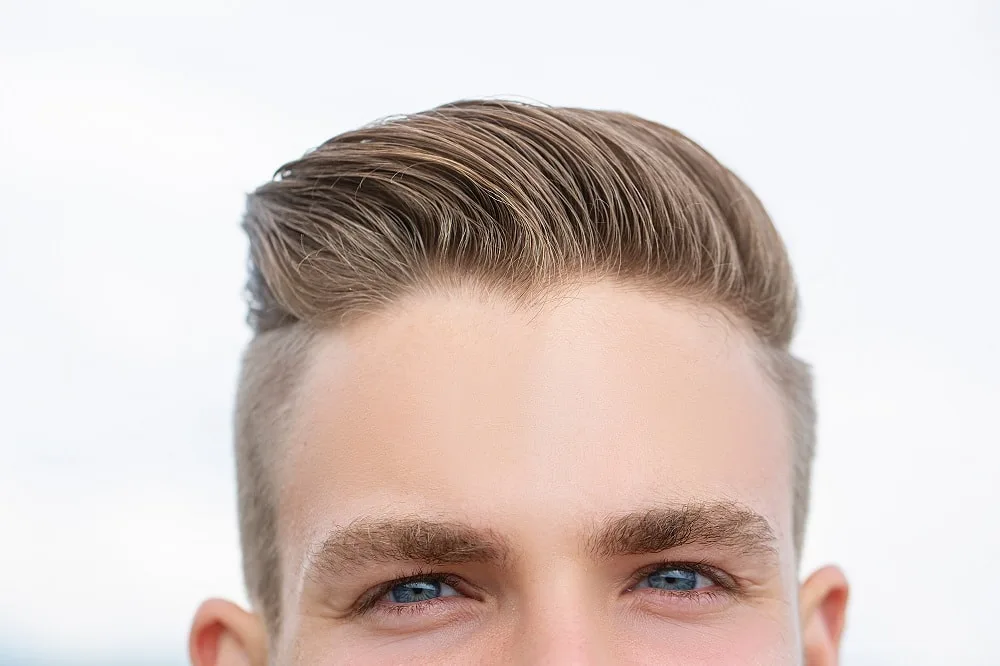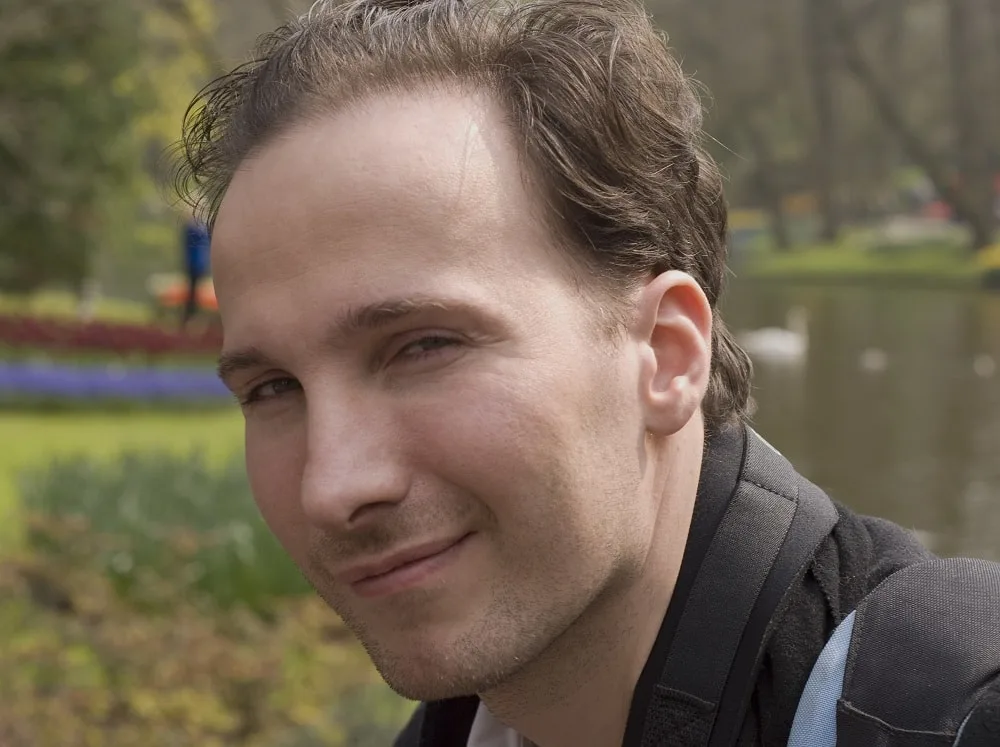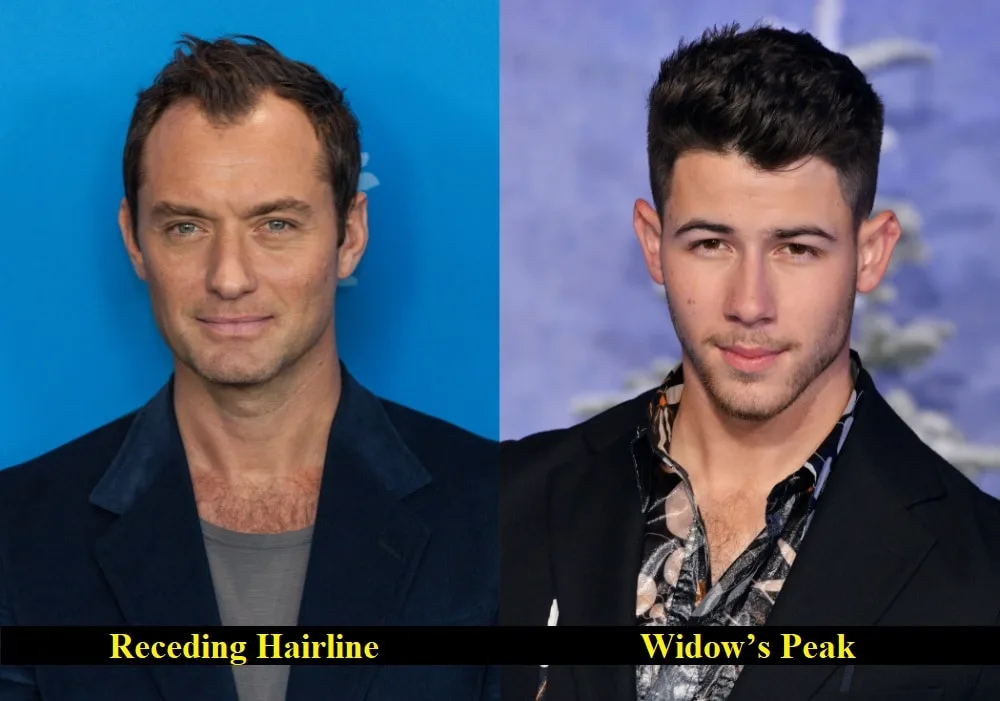As you age, you will likely notice your hairline taking on different shapes and patterns. Whether you’ve always had a noticeable widow’s peak or you’ve started to see your hairline recede in the mirror, they can be tricky to style and keep up.
The most crucial thing to remember when regarding the great widow’s peak vs receding hairline debate is not to be discouraged – you can always change your look to better suit your aesthetic.
We’ll discuss the differences between widow’s peak and receding hairline – the two prevalent hairlines, their appearance, and potential causes.
What Is Widow’s Peak?

Widow’s peak is a V-shaped hairline that’s typically a genetic trait – so if your parents or grandparents have one, you might have a widow’s peak.
Widow’s peak hairlines can be prominent or barely noticeable, depending on the strength of your gene. You may also develop a widow’s peak-like hairline if and when you start losing hair, but these are not as easy to spot as an inherited peak.
If you’re wondering why it is called a widow’s peak, research suggests that it has something to do with 18th Century funeral rituals in England. Women traditionally wore hats with triangular points on their foreheads during mourning.
In rare cases, a widow’s peak may be a sign of genetic disorders, including Aarskog Syndrome, Donnai-Barrow Syndrome, Frontonasal dysplasia, and Opitz G/BBB syndrome.
What Is Receding Hairline?

A receding hairline refers to the thinning and losing hair starting from the temple towards the crown.
Unfortunately, losing hair is one of the most notorious aspects of aging, and it happens to almost everyone. However, some individuals (mostly men) develop a receding hairline instead of losing their hair gradually.
A receding hairline can happen at any time after sexual development. The recession usually starts around the top of the forehead and stops slightly past the ears.
Some people have receding hairlines with little to no hair loss at the back or on top, while others experience more loss around their ears and temples but grow hair on the mid-section of their head.
There are a few reasons why people may develop a receding hairline. Like a widow’s peak, some receding hairlines may be genetic. If a woman notices a receding hairline, she may be going through menopause or having other hormonal changes.
What Does a Widow’s Peak and a Receding Hairline Look Like?

Although they may each look the same at some point, a widow’s peak and a receding hairline have a few differences.
A widow’s peak, if inherited and noticeable at birth, looks like a V on the forehead. It forms a distinct, sharp point that extends further than the rest of the hairline.
Some peaks are prominent, especially if the individual has thick or dark hair. Less noticeable peaks may look like a straight hairline with a slight dip in the center.
Receding hairlines generally look different depending on the person. For men, if their father had a specific hair pattern when he began losing hair, they will likely have a similar experience. Some signs of a receding hairline are:
- Thinner-looking follicles towards the hairline
- Noticeable shedding
- Dull and lifeless hair
Most receding hairlines appear rounded or jagged and may change shape throughout the recession process. Some may appear in an M-shaped pattern.
Receding hairlines may naturally turn into a widow’s peak. A sudden appearance of a widow’s peak is the first sign of male pattern baldness or androgenetic alopecia in women.
Differences Between a Widow’s Peak and a Receding Hairline
While the genetic difference is the primary separator of widow’s peaks and receding hairlines, there are a few other ways they differ.
A widow’s peak usually takes a prominent V shape in the center of your forehead, with the hair retreating noticeably on the sides. It mainly results from hereditary factors like the Aarskog syndrome, Donnai-Barrow syndrome, and other genetic conditions.
In contrast, a receding hairline typically appears as an M shape, and the primary cause is hormonal imbalances, genetics, stress and anxiety, tight hairstyles that damage the roots, and aging.
Further differences between a widow’s peak and a receding hairline are maintenance and management. A widow’s peak customarily requires no upkeep unless the tip sits off-center and grows in the opposite direction of the rest of the hair. If that’s the case, you may want to manage it with trims and parting your hair sideways.
Receding hairlines, however, are another story. You can spend hundreds on products to regrow your hair, take supplements, and even get a prescription from your physician to help control hair loss.
If you have a receding hairline and want to fix it, you cannot eradicate it – but you can slow it down. A few options you have regarding hairline management are:
- Rogaine (Minoxidil) – approved by the FDA to slow hair loss.
- Hair transplants – are expensive but one of the most effective hair loss remedies.
- Drithro-Scalp – psoriasis medication that encourages hair growth.
Those with widow’s peaks may want to get rid of their genetic hairline, and there are solutions for that, too. Hair transplants and follicle transplantation are the most common procedures for correcting an unwanted widow’s peak. Medications and supplements will not fix a natural widow’s peak.
Check out the table below for a glance at what sets them apart.
|
Widow’s Peak |
Receding Hairline | |
|
Shape |
V-shaped hairline |
M-shaped, rounded, uneven, middle |
|
Causes |
Age or Genetic factors |
Age, Genetics, High DHT, Hormonal changes, Lifestyle & Stress |
|
Ideal Hairstyle |
For men – pompadours, buzz and crewcuts, undercuts
For women – side parts, updos, soft bangs |
For men – buzz cut, quiff, shaved, slicked back For women – short bob, layers, deep side part |
|
Treatment |
Hair transplant
Electrolysis |
Minoxidil Finasteride Laser therapy Hair transplant |
|
Age of Onset |
Anytime/ naturally occurring |
After puberty |
When Do Men Begin Experiencing a Receding Hairline?
Men may notice a receding hairline as early as their late teens and 20s, especially if their father or grandfather had hair loss at that age. Hair loss can also derive from high DHT levels, which contribute to hormones and affect hair follicles.
By age 30, most men begin seeing at least a little hair loss and maybe a hint of a widow’s peak. At age 50, almost half of the men have a receding hairline and near baldness by 60.
The sooner you catch it, the better, unless you want to be bald and enjoy that look. Otherwise, spotting it ahead of time gives you time to implement a maintenance regimen or medications to slow the process.
Can a Widow’s Peak Indicate Balding?
A widow’s peak may sometimes indicate baldness, but not always. If you have a natural widow’s peak from birth, having one at 50 will not imply hair loss – but a receding hairline or thinning sides might.
Receding hairlines resembling widow’s peaks signal future balding, as they reveal the hairline gradually moving back towards the ears and up the forehead.
Remember, just because you have a widow’s peak from birth does not mean you’re guaranteed to go bald. If it develops later in life, contact your physician with concerns or treatment options (if desired).
Can a Widow’s Peak Become a Receding Hairline?

A widow’s peak can become a receding hairline, but it might look different than the standard patterned baldness. People with natural widow’s peaks usually develop an M-shaped or sharper V-shaped hairline if their hair recesses.
Generally, widow’s peaks leave hair in the middle and gradually recede from the temples, eventually balding completely. Your widow’s peak will become much more apparent if it was relatively unnoticeable before dwindling.
Final Thoughts
Widow’s peaks and receding hairlines are natural and should never cause embarrassment or shame. However, if you notice your hairline receding and want to slow the process, there are things you can do to keep it at bay.
Widow’s peaks that show themselves from birth are not as easy to fix – most people embrace their unique look and look excellent sporting side parts or pompadour!
Related Topics:
- Maturing Hairline Vs. Receding Hairline
- How To Hide Thinning Hair in the Front For Men
- M-Shaped Hairline
